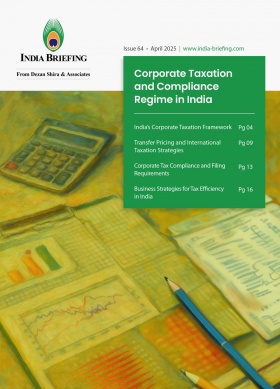US Tariff Tracker: Strategic Implications for India’s US$48.2 Billion Exports
A 25 percent tariff on Indian exports to the US came into effect on August 7, 2025, signaling an escalation in trade tensions. The US President has warned that a second round of 25 percent tariffs will take effect on August 27 if the two sides fail to reach a trade agreement, adding to the uncertainty in India–US bilateral relations.
These new tariff measures could impact nearly US$48.2 billion worth of India’s merchandise exports to the US.
Effective August 7, 2025, a 25 percent tariff on Indian exports to the United States (US) has officially come into force, as per the revised trade measures announced by President Donald J. Trump. This action follows an executive order issued on July 30, 2025, targeting nearly 70 countries under a new tariff framework.
India is among several nations impacted by what the US administration refers to as “reciprocal” tariffs, aimed at countering trade practices that Washington considers discriminatory or unfair to American interests.
US reciprocal tariffs on Indian exports
The Minister of State (MoS) for Commerce and Industry, Jitin Prasad, informed Parliament that the 25 percent reciprocal tariff on select Indian goods has come into effect on August 7, 2025. A further 25 percent ad valorem duty will apply to certain Indian exports starting August 27, 2025.
It is estimated that around US$48.2 billion of India’s merchandise export (based on 2024 trade value) to the US will be subject to the above additional tariffs.
Addressing a parliamentary question on August 19, 2025, Prasad said that the central government has acknowledged the tariff decision and stated that it remains committed to protecting the interests of farmers, workers, entrepreneurs, exporters, MSMEs, and the wider industry. It is implementing export promotion measures and pursuing trade diversification strategies to mitigate the impact and safeguard national interests.
Trump’s justification for tariff escalation
The US tariff hike in 2025 represents a continuation of Trump’s broader agenda to reorient global trade policies in favor of domestic economic interests during his second term in the White House.
Taking to his social media platform, Truth Social, Trump marked the enforcement deadline with a post:
“IT’S MIDNIGHT!!! BILLIONS OF DOLLARS IN TARIFFS ARE NOW FLOWING INTO THE UNITED STATES OF AMERICA!”
Trump has emphasized that the revised tariff regime would bring in substantial revenues from countries that he believes have long benefited from the US economy. He also suggested that only judicial opposition could hinder America’s economic resurgence.
Additional US tariffs imposed on India on August 6
In a separate executive action on August 6, 2025, Trump announced an additional 25 percent tariff on Indian exports, citing India’s continued import of crude oil from Russia. This new measure raises the total tariff burden on Indian goods to 50 percent—among the highest rates currently imposed by the US on any trading partner.
The executive order specifies that the additional ad valorem duty will apply to goods entered for consumption on or after 12:01 a.m. EDT, 21 days from the date of the order. Exceptions will be made for goods already in transit and cleared before September 17, 2025.
The imposition of additional US tariffs on Indian exports—now totaling 50 percent—has intensified pressure on Indian trade competitiveness. Many of India’s export rivals, including Vietnam, Bangladesh, and China, continue to benefit from lower duty rates, placing Indian exporters at a distinct disadvantage.
|
US Reciprocal Tariff Rates on Countries |
||
|
Country/region |
Reciprocal tariff rates in August |
Initial tariff announced on April 2 |
|
India |
25% effective from August 7; an additional 25% to come into effect on August 27 |
26% |
|
European Union (EU) |
15% |
50% |
|
China |
10% |
34% |
|
Indonesia |
19% |
32% |
|
Japan |
15% |
25% |
|
Vietnam |
20% |
46% |
Source: India Briefing
As per reports, Indian exporters have already begun feeling the impact, citing growing uncertainty and disruption in trade flows. Nearly 50 percent of the US$80 billion in annual exports from India to the US fall under the exemption list covering key items like pharmaceuticals and electronics. However, the remaining half of the exports is now subject to the steep tariff.
Impact of new US tariffs on Indian export sectors
The latest tariff hike by Trump—raising duties on Indian goods to 50 percent in addition to existing Most Favored Nation (MFN) rates—is expected to severely affect key Indian export segments, as per an analysis by the Global Trade Research Initiative (GTRI).
The decision places India among the most heavily taxed trade partners of the US, with combined tariff burdens exceeding those applied to China (30 percent) and Vietnam (20 percent) and equaling Brazil. While the scale of disruption will differ by sector, the GTRI report published on August 8, 2025, predicts a sharp decline in US-bound shipments of several high-value Indian exports.
Sectors facing the highest tariff impact
- Seafood (shrimp): Indian shrimp exports to the US, which totaled US$2 billion in FY2025 and accounted for nearly 10 percent of US shrimp imports, will now be subjected to a combined tariff of 60 percent—inclusive of the new 50 percent rate and existing antidumping and countervailing duties. This puts India at a disadvantage against competitors like Canada and Chile, which face much lower tariffs.
- Organic chemicals: With US$2.7 billion in exports, Indian organic chemicals will be taxed at an effective rate of 54 percent, compared to just 15 percent for Irish and 39 percent for Swiss exports.
- Carpets: India, the largest supplier of carpets to the US with a 35.5 percent market share and US$1.2 billion in exports, will now face a 52.9 percent tariff.
- Apparel and made-ups: Knitted garments from India, worth $2.7 billion, will attract a 63.9 percent tariff. Similarly, woven apparel of similar value will face 60.3 percent. Home textiles and made-ups such as towels and bed linens, worth US$3 billion, will be subject to a 59 percent duty.
- Jewelry and precious metals: India’s top export category to the US, comprising diamonds, gold, and jewelry valued at US$10 billion, will now be taxed at 52.1 percent.
- Industrial goods: commodities such as machinery and mechanical appliances worth US$6.7 billion will face a 51.3 percent tariff; furniture exports (US$1.1 billion) will be hit with a 52.3 percent duty. Base metals like steel, aluminum, and copper (worth US$4.7 billion) will attract 51.7 percent. Additionally, auto parts exports of $2.6 billion will see a lower but still significant 26 percent duty.
Sectors exempt from the US tariff hike
Some major Indian exports remain unaffected by the revised tariff structure, preserving their competitiveness in the US market:
- Pharmaceuticals: US$9.8 billion in exports
- Smartphones and electronics: US$10.6 billion
- Petroleum products: US$4.1 billion
India-US tariff conflict: Exporters raise alarm over cost pressures
Indian exporters have voiced strong concern over the tariff escalation, warning of severe consequences for industry margins and long-standing trade relationships.
The Federation of Indian Export Organizations (FIEO) has described the development as a “serious setback” for Indian exports. FIEO has also expressed concerns about tariff repercussions hitting India’s micro, small, and medium enterprises (MSMEs). The export body notes that approximately 55 percent of shipments to the US are now affected, placing exporters at a 30–35 percent cost disadvantage compared to countries with lower tariffs.
Similarly, the chairman of the Confederation of Indian Textile Industry (CITI) warned that the August 6 tariff hike could further weaken India’s textile and apparel sector, which is already navigating a challenging environment.
The CITI chairman has reportedly urged the central government to intervene swiftly and support the sector’s global competitiveness in line with its broader objective of positioning India as a major player in global value chains.
Bilateral trade setback for India-US amid ongoing tariff dispute
Media reports, citing industry experts, have indicated that the US is currently unwilling to engage in sector-specific tariff negotiations, particularly in areas like steel and automobiles—industries that have already suffered losses exceeding US$5 billion in export value.
Industry experts have warned that the latest trade actions could strain diplomatic relations.
India’s strategic options for tariff recalibration
After the US tariff rate unveiling, first announced on April 2, 2025, India was initially expected to be among the first to reach a trade agreement with the Trump administration by the end of the first tariff pause. However, talks stalled after five rounds, largely due to disagreements over market access for US agricultural and dairy products and India’s oil purchases from Russia.
Indian officials remain cautiously optimistic that ongoing closed-door discussions could help de-escalate tensions between the two countries. A US trade delegation is expected in New Delhi later in August 2025 to explore solutions.
India’s Prime Minister, Narendra Modi, has reiterated India’s stance on protecting key domestic sectors and safeguarding the interests of farmers, dairy producers, and fisherfolk.
India strengthening ties with developing economies
India is expected to leverage its position within global blocs like BRICS to counterbalance pressure from the US. Brazil, another key target of the US tariffs, has expressed plans to initiate joint discussions with fellow BRICS members, including India, China, Russia, and South Africa.
According to media reports citing central government sources, India is actively seeking to rebuild and diversify its international alliances and trade deals. On July 24, 2025, the Prime Ministers of India and the UK signed the much-anticipated Free Trade Agreement (FTA). This is India’s first major FTA in over a decade and the UK’s fourth since its exit from the EU in 2020.
READ MORE: India’s FTA Network: Updates in 2025
Conclusion
The sudden escalation of US tariffs presents India with a complex trade and geopolitical challenge. While diplomatic channels remain open, the economic pressure on Indian exporters—especially MSMEs—is mounting. New Delhi faces a difficult balancing act: defending strategic sectors, sustaining economic ties with Washington, and strengthening multilateral partnerships with emerging economies.
(This article was originally published on August 7, 2025. It has since been updated on August 19, 2025.)
About Us
India Briefing is one of five regional publications under the Asia Briefing brand. It is supported by Dezan Shira & Associates, a pan-Asia, multi-disciplinary professional services firm that assists foreign investors throughout Asia, including through offices in Delhi, Mumbai, and Bengaluru in India. Dezan Shira & Associates also maintains offices or has alliance partners assisting foreign investors in China, Hong Kong SAR, Vietnam, Indonesia, Singapore, Malaysia, Mongolia, Dubai (UAE), Japan, South Korea, Nepal, The Philippines, Sri Lanka, Thailand, Italy, Germany, Bangladesh, Australia, United States, and United Kingdom and Ireland.
For a complimentary subscription to India Briefing’s content products, please click here. For support with establishing a business in India or for assistance in analyzing and entering markets, please contact the firm at india@dezshira.com or visit our website at www.dezshira.com.
- Previous Article 印度《2025年所得税法案》要点解析
- Next Article Warming Ties: India-China Signal Trade and Diplomatic Reset








